Hair Transplantation Frequently Asked Questions
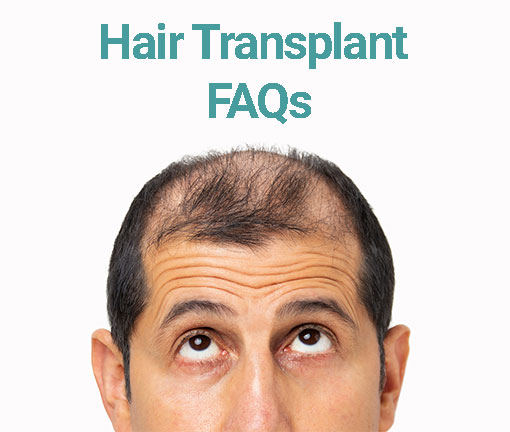
A Hair Transplant is a big decision for anyone, and before getting it done there are many questions that come to mind. People look for answers on the internet, but the internet is full of unverified facts and myths about Hair Transplants. So, getting the right answers to your questions about Hair Transplants becomes a bit tricky. Here we have tried to answer the questions which are asked most frequently before a Hair Transplant.
Who is a good candidate for hair transplant surgery?
A hair transplant is the best way to get back your natural look and hairline. A good candidate for transplant surgery is one who has healthy hair growth in the donor area, i.e., the back side of the scalp. Additionally, men and women suffering from baldness and hair thinning can choose hair transplants procedure to cure hair loss and look for a permanent solution.
Age or gender is not a limitation of the hair transplant technique. Anyone with hair loss from scarring, scalp injuries, cosmetic surgery procedures, or anyone who had prior hair restoration and hasn’t received desired results can select it. But in DHI we suggest ages above 20+ will opt for a hair transplant procedure. At DHI, patients at the age of 60-70 have had successful procedures. We have helped more than 300,000 people around the globe regain their smiles with our precise DHI technique.
How is the hair transplant procedure performed?
A hair transplant procedure at DHI clinics is followed by a scalp diagnosis. Experienced surgeons analyze hair loss conditions while focusing on desired results and the person’s medical history. Based on that, the hair transplant plan is customized for each candidate, and the number of grafts required to offer the desired results is calculated. The entire procedure is performed following three steps:
- Extraction: Hair follicles are extracted from the donor site one by one using disposable patent tools. The extracted hair follicles are then stored in the special solution at a defined temperature to keep them in the active state and enhance their development after placement.
- Implantation: Each extracted hair follicle is directly implanted into the bald area using patent tools, i.e., the DHI implanter. This tool ensures the creation of no holes or slits.
- Natural Results: DHI implanters ensure full control of angle, direction, and depth during the entire procedure, which helps DHI surgeons to offer 100% natural results and maximum viability. The implanted hair will grow naturally for a lifetime and will not fall out.
Who will perform the hair transplant procedure?
In most clinics, procedures are performed by technicians who may or may not have any medical training. The doctor who books your session mostly acts as a salesman and would be present in the procedure room only for a few minutes to give you the impression that procedures are being performed by him, or under his supervision. The bigger the doctor, the more you face this problem, as senior doctors don’t like to do laborious procedures.
At DHI, the entire procedure, end to end, is performed by qualified surgeons who have been extensively trained in the science & art of hair transplants and have gained tremendous experience even before touching their first hair transplant patient independently.
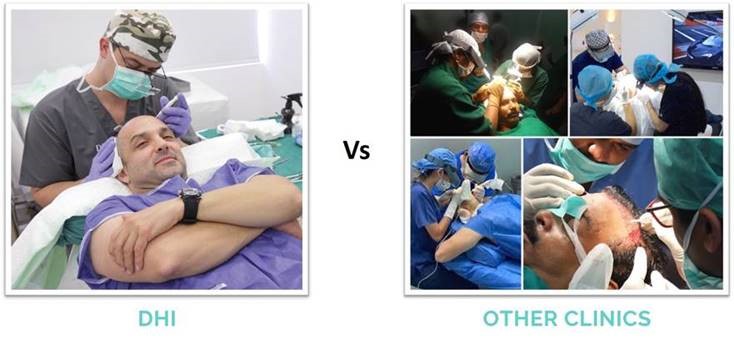
How much time is involved in a hair transplant procedure?
A hair transplant is a surgical procedure, and the time taken for transplant depends on an individual-to-individual basis, as the requirement might differ. But before considering the time required, correct diagnosis is important. DHI International Medical Group believes diagnosing hair loss is better than treating it permanently. With this goal in mind, the Unique Diagnostic System for Alopecia (UDSA) was created, a highly sophisticated hair loss diagnostic system. The main aim of this procedure is to curate a customized hair loss treatment plan that is exclusively designed for you based on your medical history, blood tests, and scalp scan.
This allows the DHI surgeons to customize the whole surgery and decide on the number of grafts required (insert link) to be implanted to offer the desired results. The entire time of the hair transplant surgery depends on the number of grafts to be extracted and then transplanted. The complete hair transplant procedure extraction and then implantation takes 4-7 hrs average time depending on the average requirements of the patient, including lunch break and visible results might rake 6-12 months, might vary from case to case. Most candidates can achieve a full and natural look with a minimum of hair transplant procedures, i.e., one to two sittings of three to four hours each.
Will I get guaranteed natural results with the number of hairs promised?
You may be surprised to know that the industry average for graft survival is only 50%, as against the DHI techniques verified 90% (10% of hairs are always in the anagen phase). There are several reasons for this. Most clinics do not implant the number of hairs that they promised, and it is impossible to verify this. The clinic typically stores the extracted hair in a heap as shown in the picture below which makes it impossible for you to count the number of hairs, as opposed to DHI where every single graft is neatly placed in a tray and the number of grafts can be mathematically verified. Please see the picture below.
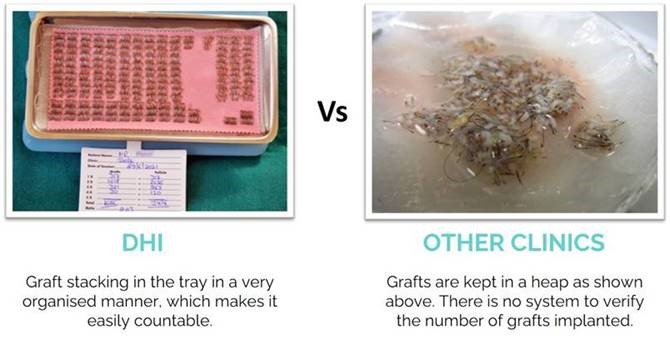
The extracted hair needs to be properly hydrated with a special solution when they are out of the body, for its survival. Since the extracted grafts are kept in a heap by other clinics most of these grafts are not hydrated properly and therefore do not survive even before they are implanted. At DHI each graft is laid separately in a tray and properly hydrated. Keeping the grafts in a heap makes it impossible to plan a proper aesthetic distribution of grafts, leading to unnatural results.
The implantations in almost all the clinics are done by using the old slit & insert method which is a two-step procedure and the surgeon does not have control over the angle, depth, and direction of the implanted hairs. At DHI, we follow a one-step direct implantation technique with DHI’s implanters, which allows perfect control of the angle, depth, and direction of implanted hairs, giving natural and beautiful results every time. DHI holds patents in the US and European Union for implanter design and Direct Implantation Techniques.
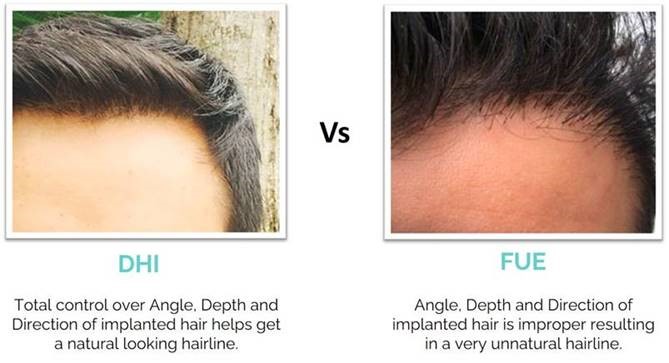
While thinking of the cost please consider the impact of 50% v/s 100% growth. Even if you pay half at other clinics, the ultimate cost to you is much higher for a sub-standard service and result.
Will the transplanted hair eventually fall out?
It is perfectly normal to notice the shedding of transplanted hair for 2-3 months after the procedure. New hair will take the place of fallen hair after a few days.
The healing process after a hair transplant can take between 6 to 12 months. After that, the transplanted hair will start growing at an average pace.
In a DHI Hair Transplant, only healthy hair follicles, excluding hair in the telogen phase, are chosen and grafted from the donor area to the balding area. This allows them to grow naturally and permanently. The DHI-trained and certified medical doctors follow strict protocols and precise techniques that allow them to ensure maximum viability rate.
Is the procedure painless? How fast can I get back to work?
You can get back to work almost the same day after the DHI hair transplant, provided there is no strenuous physical activity involved. Please see below typical pictures of extraction and implantation immediately after the DHI procedure.

At other clinics, even though they follow the FUE technique for extraction, unfortunately, the typical result looks like this, and recovery can take days.
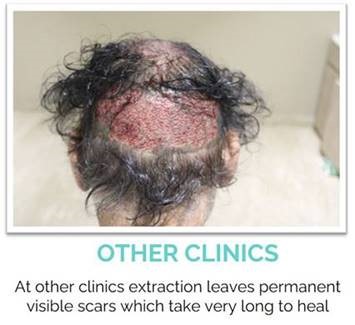
What results to expect from hair transplant surgery?
Hair Transplantation surgery gives natural-looking results permanently when done by a trained and experienced surgeon. Though this procedure offers hair growth for a lifetime, at times hair transplant doesn’t give the desired result as most clinics do not follow the protocols which are required in a hair transplant procedure.
DHI technique gives complete control of Angle, Depth, and Direction. At DHI the entire procedure is performed by highly trained surgeons to ensure 100% natural results and a more than 90% graft viability rate. Approximately within 90 to 100 days, new hair will grow and continue to grow at a natural pace. The natural appearance of the transplanted hair will begin within six to nine months of the surgery.
Are there any complications from the hair transplant procedure?
The Hair Transplant treatment is a surgical procedure. However, in this permanent hair loss treatment, complications post and during surgery are rare and generally nothing. But like any other surgical procedure, a hair transplant also involves some risk if not done by an expert surgeon or non-certified surgeon or performed by a technician or nurse at a clinic with compromised infrastructure. If the doctors/clinic not followed safety and hygiene protocols during surgery, and the instruments used in the surgery are not single-used. Proper care is required after undergoing a hair transplant. If you do not care for the treated and donor area, it could cause complications such as bacterial infection, folliculitis infection, etc. In such cases, ensure to contact your surgeon for further guidance immediately.
At DHI, well-defined medical SOPs are followed for every hair transplant surgery at each hair transplant clinic. The entire procedure at any DHI clinic is done solely by a trained surgeon which eliminates the chance of any complications.
Is male-pattern or female-pattern baldness common? Why am I suffering from it?
Hair loss is very common among both males and females. Everyone loses approximately 50 to 150 hair per day, but they grow back. If hair follicles are thinned, and re-growth stops, it can lead to hair loss. Other factors such as hormones, natural aging, lifestyle change, and more can cause hair loss. You must consult a hair specialist when you notice an unreal hair fall. It will allow you to find the best solution at the right time.
The female baldness pattern is very different from the male, and hence the requirements of a female hair transplant are different from a male hair transplant. At DHI a complete diagnosis is done before customizing the hair transplant procedure recommendation.
Is a hair transplant painful?
Being a surgical procedure, a Hair Transplant patient might experience some pain if the transplant is done by any technique other than DHITM – Direct Hair Implantation hair transplant technique. The DHITM (Direct Hair Implantation) is a virtually painless technique for hair transplant procedures as it is the most advanced technique in the hair restoration industry. DHI procedure is performed by experienced surgeons using local anesthesia and it eliminates the discomfort and pain during the procedure. The surgeons at DHI use patented tools to perform the surgery to ensure 100% results, with no pain, scars, or stitches.
Will I be able to play sports or swim immediately after a hair transplant?
It is advised to avoid any kind of strenuous physical activity like sports or swimming for at least two weeks after the transplant surgery. But the hair transplant procedure performed by the DHITM technique is having no downtime, which means patients will go to their daily routine activities after 1-2 days once the bandage is removed from the donor area. However, heavy exercises and scalp exposure to direct sun and rain should be avoided as this can cause complications in the results of a hair transplant treatment. You must always consult your surgeon for more details.
What happens after the surgery?
- Transplanted hair starts growing naturally three to four months after the procedure, and the full results of the surgery can take around a year to show.
- Some candidates may notice some redness, crusting, swelling, or tiny scabs on the donor or impacted sites; this is natural and will vanish within a week. Do follow all the post-surgery instructions as given by the surgeon and the clinic.
- Some transplanted hair might fall out after the surgery, but the hair follicles will remain, and new hair will grow back within a month.
- Most patients can return to work within 24 to 48 hours of the DHI transplant.
- Physical activities, such as sports, swimming, and exercising, should be avoided for at least fifteen days after the surgery.
- All the medications and instructions provided by hair transplant specialists should be followed to minimize side effects.
- Any numbness in the donor or the treated area will disappear with time.
Visit your hair transplant surgeon at the decided period of time to get updates on your progress and results.
What precautions should be taken pre-and post-hair transplant surgery?
Pre-hair transplant surgery:
- Avoid consumption of vitamins, aspirin, alcohol, and smoking one week prior to the surgery.
- Follow the DHI TCC (Total Care Consultant) instructions if you are suffering from high blood pressure or diabetes.
Post-hair transplant surgery:
- Consume prescribed antibiotics and anti-inflammatories for a few days after the surgery, as prescribed by the surgeon.
- Heavy exercises, swimming, and scalp exposure to the direct sun should be avoided for fifteen days after the surgery. Light exercise or walking can be resumed a week post-surgery.
Is any long-term medication required post-surgery?
No long-term medications are required after the surgery as the implanted hair will grow naturally and permanently. However, to avoid thinning and falling of existing hair, doctors may suggest the application of minoxidil.
What is the success rate of the hair transplant?
The success rate of a hair transplant depends on the natural result. DHI clinics focus on the three very important aspects of hair transplant i.e., design, direction, and density to ensure natural results. DHI surgeons use patented and precise instruments throughout the procedure that helps them offer a high success rate of the transplant and 100% natural-looking result every time.
Does transplanted hair look natural?
Yes, the transplanted hair will look 100% natural if done by a trained and experienced surgeon. DHI Hair Transplant is performed by trained doctors from start to end, following global standard SOPs. It ensures that the transplanted hair is undetectable and grows naturally. It is impossible to identify the difference between natural and transplanted hair once they achieve natural growth.
What safety and Quality Assurance protocols are followed by the clinics?
A hair transplant is a virtually risk-free procedure as it is minimally invasive. However, due to old-fashioned techniques followed by some clinics and the absence of any medical/safety protocols in writing, even this relatively harmless procedure can become dangerous. The doctors and assistances in many clinics are not properly trained on the use of local anaesthesia, durations of procedure, managing contraindications, and all this can be risky at times for the patients.
Every clinic of DHI follows very strict safety and medical protocols as per standard operating procedures running into hundreds of pages. These SOPs are accredited by UK’s Care Quality Commission which sets the patient safety standards in London. At DHI, every procedure goes through a quality assurance check by Medical Director.
In most clinics, the instruments for hair transplants are reused after sterilization. This creates uncertainty about the sterile nature of the instruments since you are dependent on the perfection of the sterilization process. This can lead to complications including serious infections. At DHI all the instruments (excluding tools) are single-use only.
Is hair styling after a hair transplant advisable?
Hair styling should be avoided for at least a year post-hair transplant. After the surgery, transplanted hair grows slowly. Hair styling products, such as sprays, gels, and mousses, are harsh and can create barriers to the growth of transplanted hair. Also, hair dyes should be avoided till the hair grows properly. You can consult your hair specialist for further guidance.
Is there any special training required for performing a hair transplant?
Hair transplant candidates should always prefer surgeons with appropriate training and experience to ensure the best results. Many doctors claim to perform hair transplant surgery, but only a few have proper training and experience in the field. It is advisable to avoid them and research well before getting a transplant done.
At DHI India, only doctors trained in DHI Total Care System and certified by DHI International Hair Restoration Academy perform hair transplant surgery. They use DHI-specialised techniques and patent tools to ensure the right depth, angle, and direction of hair grafts and offer 100% satisfactory results. It makes them the best hair transplant doctors in India.
What is the cost of a hair transplant?
Like other cosmetic surgeries, hair transplants can sometimes be expensive. By spending that amount, you can achieve permanent and natural hair growth, which is priceless. Whenever you spend your hard-earned money on a hair transplant, ensure that the clinic doesn’t take any shortcuts, as it can impact the overall result. You should also consider other factors, such as who performs the surgery, artistic skills, the experience of the surgeons, safety and hygiene protocols followed by the clinic, the number of grafts required to get desired results, and instruments involved in the surgery.
DHI clinics set the gold standard for quality, experience, density, natural results, safety, and technology. At DHI the hair transplant procedure is customized for each candidate, making it unique. That’s why it is advisable to meet a DHI hair restoration expert at the DHI clinic near you to find out the cost of the surgery.
What technology do DHI clinics follow?
DHI clinics follow the most advanced hair transplant technique in Hair Transplant industry. i.e., DHITM– Direct hair implantation technique. Direct Hair Implantation is pioneered by DHI and is only offered at DHI clinics. The entire procedure is performed following the patented methodology, with patented DHI implanter and single-use instruments. The standard operating procedures (SOPs) are followed globally at each DHI clinic to guarantee 100% safety.
Why is proper diagnosis important before a hair transplant?
Successful treatment depends on proper diagnosis. A diagnosis before a hair transplant helps hair transplant doctors to understand your requirements, the condition of your scalp, and the reason for hair loss. At DHI, the unique diagnostic system for Alopecia, i.e., the unique diagnostic alopecia test (UDSA), is followed. It is a dermatological examination that allows DHI doctors to identify the alopecia type and prevailing conditions. It assesses the magnitude of the problem and the amount of hair available for exportation. Additionally, DNA analysis and stress analysis are performed under it.
For further hair transplant-related questions, book your hair transplant consultation online and avail 50% OFF on consultation fees with hair transplant experts at DHI.
